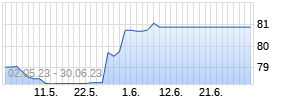
Die jüngsten makroökonomischen Daten haben die Hoffnung der Anleger auf eine schnelle Desinflation zunichte gemacht.
10.03.2023 - Despite cautious central bank communication about the policy outlook, particularly in view of the persistent strength of labour markets, investors were expecting rate cuts in the second half of 2023 amid a fall in global inflation. Yet, recent macroeconomic data has poured cold water on their quick disinflation sanguine view.
Will (and can) central banks tolerate stronger growth?
The February business confidence points to a return to growth, amid supply chains improvements and China's reopening from COVID lockdowns. Yet, while bottlenecks continue to fade, the output price sub-component in the manufacturing sector remains stuck at an elevated level, raising the risk of goods inflation becoming entrenched. Meanwhile, tight labour markets risk feeding price pressures in the services sector. Against this backdrop, investors were forced to revise upwards their terminal policy rate projections, while pushing out the timing of expected rate cuts. In the US, hotter-than-anticipated CPI, PPI, and PCE inflation prints suggest inflation is likely much stickier compared to investors’ hopes. What’s more, recent US data releases brought renewed evidence of strong labour market conditions. More than 500,000 jobs were created in January and the unemployment rate fell to the lowest level since 1969(1). Furthermore, initial jobless claims edged lower again in February, and the Conference Board consumer survey showed the percentage of households judging jobs are plentiful moved up for the fourth consecutive month in February, providing further evidence that the labour market still isn't cooling. Correspondingly, wage pressures are likely to remain robust.
Meanwhile, unit labour costs were stronger than initially estimated in Q4-22 amid a sharp downward revision to productivity growth, also suggesting price pressures stay stubbornly elevated. In turn, some Fed members have floated the idea that a return to 50bps hikes could be justified, and almost all of them insisted the “higher for longer” approach was needed more than ever. In the 2004-06 tightening cycle, the Fed funds rate rose to 5.25 per cent and the 10-year Treasury yield peaked at around that same level(2). Today, the Fed is poised to lift short rates to similar levels or even higher, but the 10-year Treasury yield is much lower - a development worth monitoring, although lower estimates of potential GDP growth might in part explain the difference. In the Eurozone, inflation was much stronger than expected in February, according to the flash estimate, with headline inflation slowing less than expected, from 8.6 per cent to 8.5 per cent. Excluding food and energy – a key focus for the ECB – inflation quickened to 5.6 per cent from 5.3 per cent, a new record(3). As the spike in energy costs continues to moderate, thanks in part to a mild winter, elevated core measure suggests price gains continue to permeate through the economy. This could lead workers to seek larger pay rises amid a robust labour market, and thus spark a wage-price spiral, especially if inflation expectations become unanchored as the inflation is too slow to return to target. The unemployment rate was unchanged in January at 6.7 per cent, the lowest level since the beginning of the euro(3). Incidentally, the ECB will hike interest rates by 50bps at the meeting on 16 March, and might have to add at least 75bps more by the end of 2023. In sum, buoyed by hopes that the recent loosening of pandemic restrictions will feed through to improvements in the Chinese economic activity, whereas Europe’s recession fears have evaporated, investors have revised upward their global growth projections. However, central banks might very well take a negative view of the improvement in the economic outlook and, cynically to some, prevent any acceleration in global growth by tightening their monetary policies even more.
Lessons from the 1970s
The surge in consumer prices of the past two years has ignited the worry that the global economy could face a period of persistent high inflation. The commodity price surge in the wake of Russia’s invasion of Ukraine has exacerbated already elevated inflationary pressures driven by the pandemic’s supply disruptions, both in the goods sector and labour market. In that regard, the situation resembles the 1970s supply oil shocks. Furthermore, then and now, monetary and fiscal policies were accommodative in the run-up to these shocks. However, the 1970s were a time of considerable structural economic rigidities, as collective bargaining covered four-fifths of employees on average OECD countries. As such, general wage indexation was a powerful force in the wage-price spiral: when consumer prices rose by 1 per cent, wages automatically rose by 1 per cent, which increased firms' costs in proportion to their wage bill, pushing up prices. But in the 1980s, most countries decided to stop indexation clauses as these schemes involve the risk of upward shocks to inflation lasting longer. Greater economic flexibility, with a less centralised wage setting, also allows a faster supply and demand response in sectors where prices are rising particularly rapidly.
In addition, the absence of automatic indexation allows businesses to modulate wage revaluations according to their capacity to pass on the increase in costs to their customers, and they might spread revaluations over time, depending on the evolution of their margins. Furthermore, there has been a paradigm shift in monetary policy frameworks since the 1970s. During that period, central bank mandates incorporated multiple competing objectives, including for output and employment, and policymakers were inclined to attribute rising inflation to special factors, underestimating the pervasive and lasting impact of excess aggregate demand pressures. In contrast, today’s central banks have clear mandates for price stability, expressed as an explicit inflation target, and have established a credible track record of achieving their targets. As a result, inflation – in particular, core inflation – has become less sensitive to inflation shocks. Overall, synchronous policy tightening around the world contributed to the global recession of 1982, with global inflation waning to around 5 per cent per year, on average, in the remainder of the 1980s, compared to more than 10 per cent a year on average between 1973-83(4). Thus, a key lesson from the 1970s is that central banks need to act in a pre-emptive manner to avoid a loss of confidence in their commitment to maintaining low inflation, specified today in their inflation targets. It is also critical to avoid inflation de- nchoring where households and businesses would base their wage and price expectations on their recent inflation experience, which would enhance the risk of wage-price spiral despite the absence of indexation clauses. Will today’s central banks embrace this short-term pain for long-term gain?
Finden Sie hier den vollständigen Artikel "Monthly Macro Insights | March 2023" (in englischer Sprache) mit Grafiken.
(1) Source: U.S. Bureau of Labor Statistics, March 2023.
(2) Source: Bloomberg.
(3) Source: Eurostat, March 2023.
(4) Source: World Bank, March 2023.








